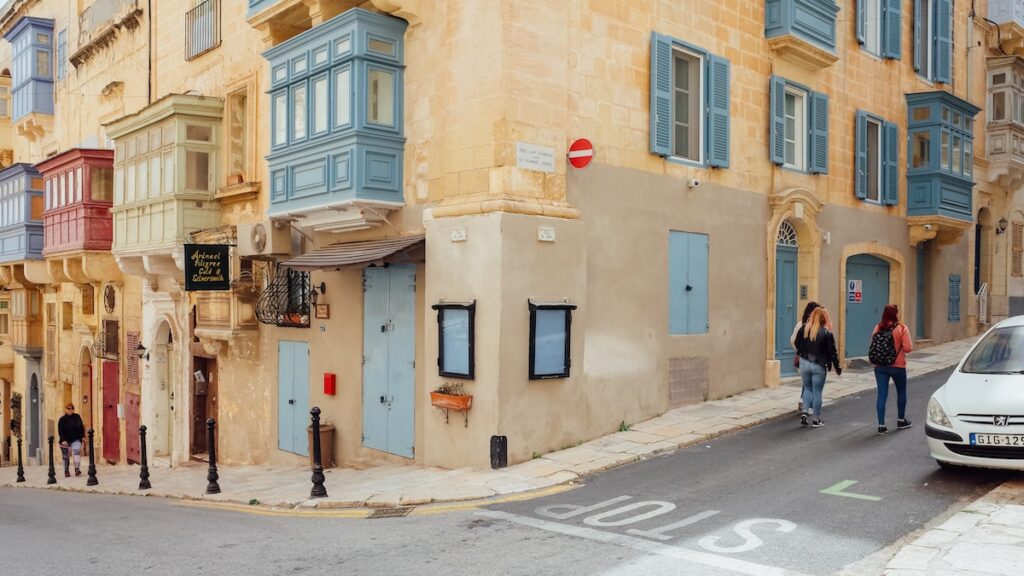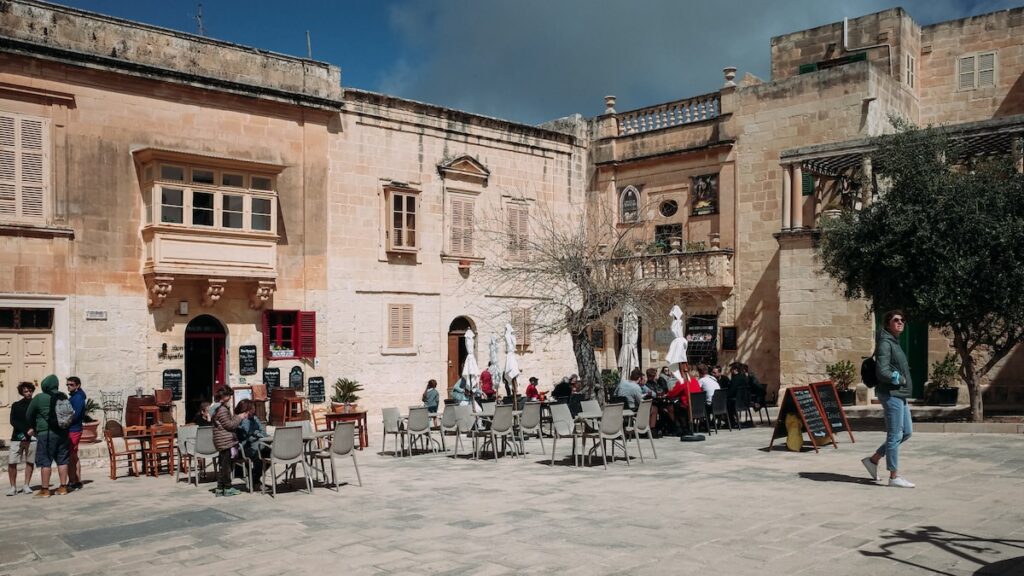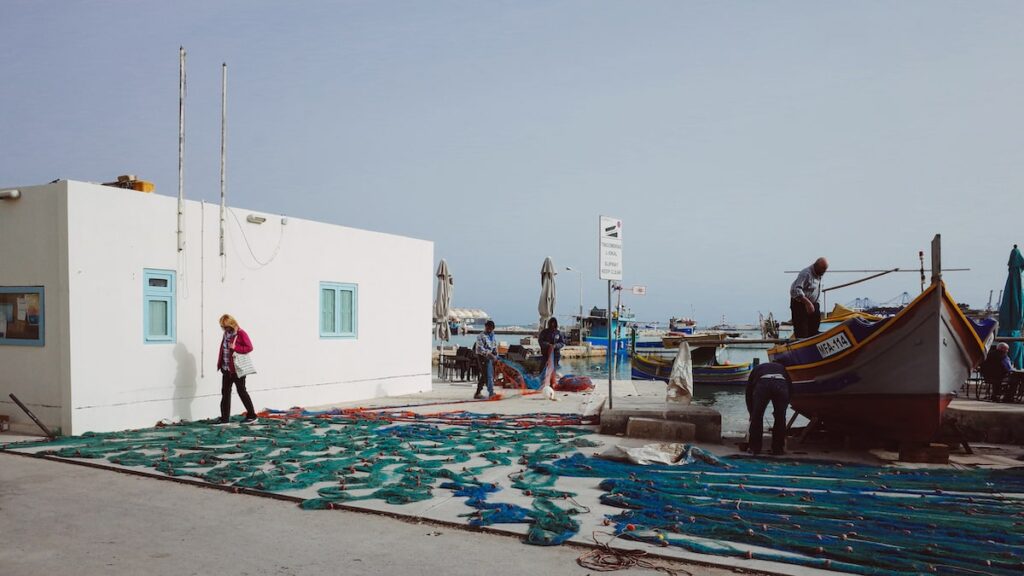Dear Barbara,
On the first afternoon in Malta, the sea changes sides as if trying to hide all the shores of the Mediterranean Sea. On this proud rock where the Knights once repelled the Ottomans, Valletta hangs on the edge like a baroque pearl. The streets dip abruptly and rise with difficulty: the only consolation is the narrow alleys, which in the distance, below hundreds of steps, fleetingly show a slice of the sea.
Valletta is smaller than the shopping center of a European suburb. From the Valletta Gate to the fortress of St. Elmo, which separates two harbors but once separated two worlds, it takes no more than twenty minutes to walk. However, this small town named after a Magister has few inhabitants but is decorated by thousands of eyes: the Maltese balconies.
All the houses in Valletta -but also far from it- extend towards the street. The enclosed balconies, made of wood and dressed with glass on the upper part, protrude from the walls. Descendants of Arab architecture, the so-called Gallerija, have reached Greece as an echo in the form of the hayati. However, in Malta, balconies indicate the standard of living: the more glass they have, the more expensive they are.
Their colors vary but are usually the same as the front door. It is said that the Grand Master watched the traffic in the square from the balcony windows of the Palace. The residents probably did the same. In Malta, the first look seems to be more important than History.
Each glass surface in the Maltese balconies becomes an eye that oversees the city. If you add the statues compulsorily built on street corners, one can only suspect how many glimpses were frozen in time. The history of each balcony is a unique pair of binoculars to transcend the present and see further into the past.
Far away from Valletta -and back to it

By leaving Valletta some mornings and returning in the evenings, I feel that interest in modern city life has been regained. These abrupt departures and arrivals are not only helpful in wandering. Every return to a city that one can afford to live in for a few days somehow keeps History aside and magnetizes the needs of everyday life.
Interest in Maltese architecture fades suddenly when one needs to charge a smartphone; the names of the statues in Upper Barrakka Gardens seem insignificant when one has to catch the bus; the Caravaggio in St. John’s Cathedral becomes less relevant when thirst leads to the entrance of a sad supermarket.
It is a moment of contrasts and revelations: in the end, one sacrifices a visit to a monument for a plate of food. Satisfying the daily needs -that remind you of mortality- is the only way to remain active in the hidden spectacle of the world. But, then, only the quality of the city can decide: it will either reassure or irritate.
In the ideal cities of the Renaissance, the disorder is the helplessness of the place to manage itself. The houses are compact, and these sand-colored tints make Valletta a rather generous place. The wind that whips every bench, the palm trees that rustle in front of the old hotel, and the Three Cities with the beach promenade all have a calming effect.
However, the disorder here is verbal. Into this strange language, the word “Sir” has been incorporated. The old English colony has kept titles and salutations that seem incompatible. No traveler, in Valletta or anywhere else, should be addressed as “Sir.” To leave means to give up titles and statuses. On the road, the ideal is not even to have a name.
The silent city of Malta has voices

A few weeks earlier, in cheerful Gothenburg, the mind was constantly returning to the war. However, this morning in Mdina, no one remembers the war, but neither cares about peace. Successive new normalities overlap the previous ones to the point where one wonders if our already incomplete lives are further devastated.
Mdina, the old capital of Malta, is now a silent town. Time forgot her, and only the yellow walls and the small palaces of the nobles remain. Few residents still live here, and the cathedral is losing its luster. The beautiful cities that are losing their imprint are surrendering without a fight to the footsteps of tourists. If there’s one thing you can do in Mdina, it’s to wander the slender alleys that lead to squares.
With its stunning well, Piazza Mesquita is the inevitable stop -as is Fontanella for a view from above. Sooner or later, however, like a misspelling of History, one comes across the Greeks’ Gate. This is the old slave entrance to Mdina, and the misspelling is that coming out of there, you come across Rabat.
Less well-preserved but more daily, Rabat (which means suburb in Arabic) has few attractions and more cars. A cathedral, the catacombs of St. Paul -and that’s all.
In an immigrant hangout, the traditional pastizzi are filled with fresh ricotta. It’s time for a quick snack that costs as much as candy in other cities while letting the sun burn your face for the first time this spring. Someone asks for a cigarette or money, but no one gives him anything. “Damn tourists,” he says and sits on a bench as one sits in the living room of a house.
Gozo and the Aging Stones of Malta

Moving from city to city in Malta is not done by intercity buses: one has to endure almost a hundred stops for a distance of thirty-five kilometers. Whether Malta treats all settlements as suburbs or if it is a way of signaling its urban cohesion is unknown. Therefore, the route to Cirkewwa crosses half the country.
In the port of Cirkewwa, ships chartered from Greece prepare for the short trip to Gozo. On this island, one of Malta’s three, Ulysses, supposedly spent seven summers by Calypso’s side. This is one of the many speculations about the location of the island of Calypso (maybe in Gavdos outside of Crete, maybe somewhere in the Atlantic, maybe in Gibraltar).
Dust from Africa has settled around the island. All the buildings are made of stone, but construction is booming on the island. The construction sector is the most important indicator of prosperity but often also of horrible taste. In Gozo, stone gives way to cement. High-rise buildings are being erected to accommodate future vacationers.
Some vortex of deception seems to be circling the island. Since the Azure Window collapsed from a storm, Gozo has been looking for a new magnet. Perhaps Ggandija, the oldest temple complex on the planet, is not enough for the future. The impressive Ta’ Pinu Cathedral may also approve of the change in scenery. Even Calypso’s cave might not be enough to seduce anymore.
Is the alternative a small Dubai of Europe? In a melancholic discussion about the Maltese stone, the analysis of local pensioners becomes a palette of colors. “Young stone is always yellow,” they say. “But limestone ages -and it ages fast.” And then: “When the stone gets old, it turns gray. They build with cement the color of the old stone from here to Saint Julian’s Bay.”
However, the castle city in Victoria is not saturated. Although the modern settlement has the characteristics of newer cities, the fortress on the rock remains untouched. The whole Cittadella is a stunning terrace overlooking the Mediterranean. One can walk it five times in an hour and never get enough. It’s like wandering inside a golden shell.
Mesmerizing sights in Marsaxlokk, Malta

The final stop is Marsaxlokk. This tongue-tied fishing village is famous for its endless bay with colorful boats. These waterside walks are always a reason to travel to the Mediterranean. Men are hewing wooden boats called luzzu, and women are watching from balconies, surprised by the sudden heat.
The distances on the island are short. It takes a quarter of an hour to get from Marsaxlokk to the airport. The last palm trees, the striped boats, and the Knights that never left. It is a delightful fishing village covered in desert dust.
The fishing nets are the color of the open sea and spread over the cement. They dry, get untangled, and prepare for the next sortie. When the boatmen pull them, a hissing sound is heard. This takes some time, like a ritual that, if followed to the letter, will mean a good omen for the catch.
It is a mesmerizing sight here in the south of Malta. When the taxi appears in the distance, they pull the last knots. And when the car leaves for Valletta airport, the nets have been collected. All that’s left is the cement.
Love,
George
More about Malta: Thomas Pynchon in Valletta, 4 days in Malta guide
Pin it for later

Sharing is caring. Share this Malta travelogue with your friends.
Last Updated on October 2, 2024 by George Pavlopoulos

